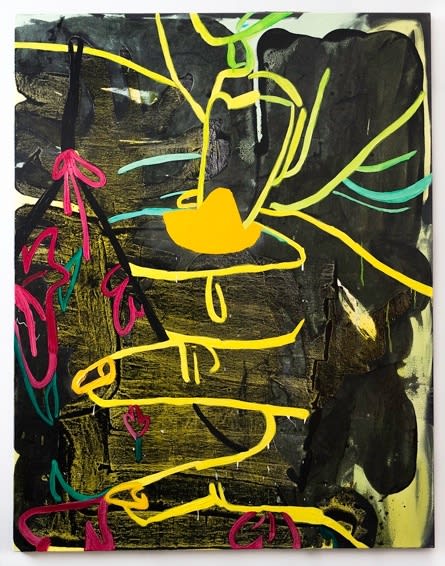At a cultural moment in which painting is on the ascendant, feminism is a buzzword, and provocation is the province of the Republican Party, it’s hard to be a provocative feminist painter. It’s even harder when, in an artistic landscape dominated by the conceptual and abstract, you embrace a retrograde semi-figuration that recalls the Bay Area Figurative School of the 1960s. Yet Queens-based, RISD- and Yale-educated artist Sarah Faux is quietly emerging as the Lena Dunham of fourth-wave feminist painting, foregrounding ambiguous, uncomfortably raw female bodies and embracing sexuality more concerned with its own contradictions than the viewer’s reaction. “As a woman in a world that objectifies the female form, I’m thinking about the body as object and agent” says the 29-year-old, her speech peppered with references to “gender binary bullshit” and Freud. “There’s this dichotomy between the outside and the inside of the body, but there are also moments of intimacy when the separation breaks down, when your walls are penetrated.”
Faux’s paintings – flat expanses of color that resolve and dissolve into representation and abstraction – focus on the moment when that sense of bodily integrity becomes fragmented. Like a hipster Matisse, Faux bends disjointed bodies to fill the frame, straining society’s limits with the viscera they would confine: female limbs, torsos, tongues. She eschews heads for naked breasts, probing fingers, and slick, hairy vulvas. “I had a professor tell me my work was a meat market,” she says. “No, I’m not going to put heads on bodies because bodies alone make you uncomfortable,” she would answer (and still answers now). “I’m trying to force the viewer into closer proximity and communion with, and acknowledgement of, the body.”
Faux’s bodies, as in traditional feminist art, critique the objectification of the female form while underscoring its vulnerability. (As a child, Faux was often ill: “I was very conscious of my body and that [it] was not always in synch with how I felt.”) But that fragmentation doubles for the multiplicity of desire: Faux’s most recent work depicts couples engaged in acts both violent and tender, their bodies splintering with polymorphous emotion. “Sexuality is complicated,” Faux says. “Sometimes you have experiences that are alienating, sometimes you’re in your body, and sometimes you’re out of it. Sometimes you want pleasure, sometimes pain. I’m trying to express a fuller range of experience.”
Painted from a slippery first-person point of view that could be both the subject’s and the viewer’s, the female form – beautiful and abject, the placid colors of an L.A. sunset belying the viscous paint and violent brush strokes – is no longer strictly subject or object, dominant or submissive, probed or probing, violated or exalted. In the invitingly pastel-hued "Untitled" (2015), for instance, phallic protuberances rise out of what could be the female reproductive system covered in menacing spiky hairs. In Faux’s work the female body is content to be all things only to the person who matters most: herself.
Fuller, Gabriella, “Up and Coming – Sarah Faux”, published in: Surface Magazine, Issue 126, March 2016



